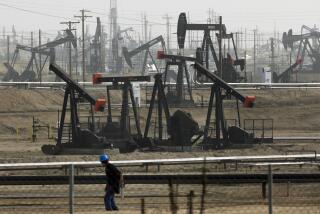Petroleum Scientists Seeking New Technology : Costs Could Kill Off Oil Platforms
- Share via
FRIGG PLATFORM, in the North Sea off Norway — Offshore oil platforms, man-made colossi built to resist waves and storms while sucking hydrocarbons from beneath the world’s oceans, may succumb to the forces of business, rather than those of nature.
The mounting cost of the skyscraper-size platforms--a new project is looking at $6 billion--is pushing petroleum scientists and engineers worldwide to explore new, experimental technology.
Already, their suggestions include rigs that swivel or float, even entire oil-production fields, repaired by robots that sit on the seabed itself.
For years, artificial islands with names like Ekofisk and Frigg have provided Western consumers with an increasing share of their natural gas and oil. Huge engineering projects mobilizing thousands of workers, these platforms were built along principles tried and proven on earthbound gushers.
“Oilmen are by nature conservative,” said Francois Bernard, a director of Elf Aquitaine, the French oil company. “When they decided to hunt for oil offshore, they did it by moving established technology into the water, toe first, then feet first.”
As long as seas remained shallow and relatively calm, companies could perch platforms on steel or concrete stilts and put wells within easy reach. However, with geologists making finds in deeper, stormier waters like the North Sea, entrepreneurs have begun seeking alternatives to fixed platforms to support valves and machinery.
“If we keep expanding the platforms, they’re going to become absolutely unwieldy,” said Jean-Jacques Roulmann, spokesman for Esso France, an Exxon subsidiary. “Exxon, and everyone else, is now experimenting with other ways.”
In the North Sea between Scotland and Norway, the drawbacks of platforms become clear. From the air, the complexes of Ekofisk and Frigg look like giant lily pads floating on a pond. Up close, the archipelagos of steel and concrete standing in 300 feet of water and more betray their true scale and cost.
The six platforms of the Frigg gas field, 90 miles off Norway’s west coast, took 20 million man-hours to build and cost a consortium led by Elf Aquitaine more than $2 billion. A single rig for Statfjord built by a Mobil Corp.-led group for 480-foot seas is almost as tall as the Eiffel Tower and is more than a hundred times heavier.
Platform size is no guarantee of safety, another reason companies are looking for other solutions. In 1980, the Alexander L. Kielland, a drilling rig converted into a hotel for oil workers, turned over in the North Sea, killing 123 workers. Two years later, the Ocean Ranger went down in a storm off Canada, and 84 people died.
Nevertheless, the current race of fixed platforms is dwarfed by what is planned for the near future.
For the Troll field off Norway, operated by the Royal Dutch-Shell Group, engineers have blueprinted a three-legged monster that would be more than 1,400 feet high, taller than the Empire State Building. Its weight: more than 2 million tons. Its price tag: more than $6 billion.
Those kinds of figures have U.S. oilmen and their foreign counterparts looking for better, and cheaper, ways to mine the riches under the ocean floor.
“Expenses are reaching a scale that is crazy,” said Pierre Chouzenoux, managing director of Elf Aquitaine’s Norwegian affiliate. “The principal problem for us now is to invent a new technology that works and that can be combined with what we already have.”
As one possibility, Elf Aquitaine is testing wellheads on the seabed with undersea pipelines to bring oil and gas to land. An experimental submersible rig called Skuld is to be tested in a Norwegian fjord to simulate 20 years of gas production in 12 months.
“This is the system that’s going to assure our energy independence by the year 2000,” said Marc Freudenreich, Skuld’s project manager.






